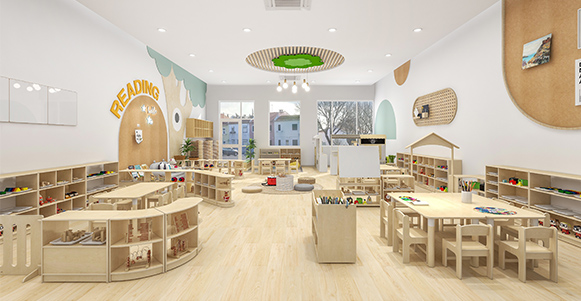Childcare Design
ChildCare Design
Childcare design is for children aged 0-6 years. The childcare center is designed as a transition for children from home to school. Through the close cooperation between parents and teachers, children can gradually get rid of anxiety and leave their parents. The teacher supports children’s natural development with respect and gentleness and encourages children to be independent. Children in small classes begin to lay the foundation for future development. They gradually form their own personalities, establish life goals, develop social skills, and begin their learning journey.


ChildCare Design
Nowadays, more and more parents are beginning to pay attention to the physical and mental development of infants and young children. Therefore, the industry development situation of childcare centers is very good. In order to enhance their competitive advantages, operators have begun to attach importance to childcare. The design of the childcare center attempts to reflect the space value and corporate culture value of the childcare center through the design to enhance its own strength. Today, let’s take a look at the design content of the childcare center?
Reflect the value of space:
First of all, the most important thing in the design of a childcare center is to help it enhance the value of the space. A professional childcare center design can make a limited space generate unlimited value. As far as childcare is concerned, the unique functions of each space are reflected through scientific and reasonable design, such as a play area, and the environment can be used to stimulate children's potential through some designs.
Show cultural ideas:
Secondly, the design of the childcare center should also show the corporate culture and education concept. The main purpose of the design is to integrate culture into the space, so that the space can generate greater value, and more importantly, it can help the organization to carry out later publicity and promotion.



ChildCare Requirement
The classroom is a small community. Here, we divide the classroom into several areas to help children focus and arouse their interest. The personal care area focuses on cultivating children’s hygiene habits. We instruct children to put on and take off their clothes and eat by themselves. This area is full of language and sensory communication, and children get real experiences through their own hands. Carefully selected teaching aids are placed on the shelves in the classroom. Various teaching aid activities promote the physical development of children and encourage them to make progress in art, music, and various operating games. These teaching activities designed based on real-life are designed to help children perfect various skills.


ChildCare Design Layouts
A childcare is a place where the life and potential of 2-3-year-old infants and toddlers are stimulated. At this stage, children are too young, have weaker body immunity, and have almost no awareness of safety precautions. Therefore, the design and layout of the childcare center should reflect the scientific and humanistic nature. Therefore, the whole space needs to be scientifically planned when designing, so that space can show greater value and help children grow up physically and mentally.
First:
Make a reasonable plan for the space of the childcare center. If the space is sufficient, you can set up more function rooms, if the space is not enough, you can design the classroom to show more functions. Therefore, regardless of whether the childcare center is large or small, reasonable planning can help children's physical and mental development.
Second:
The design of childcare centers should also pay attention to the use of small spaces and corners. For example, the stairwell can be designed to be a storage room, which can effectively avoid the dead corners in the space and give full play to its greater value.
ChildCare Classroom Furniture


ChildCare Set Up
1. The functional characteristics of the childcare classroom
For small and medium-sized childcare centers, the reason why they should pay attention to classroom design is that a classroom has many functions, such as diapers, washing, breastfeeding, playing, etc. The younger the child, the more functions the classroom needs. Therefore, the design classroom of the nursery school should consider various factors comprehensively, divide the area reasonably, and create greater value in the limited space.
2. Precautions for preschool classroom design
The day care layout design of nursery school should also pay attention to the differences in their functions for babies of different ages. The older the month, the things that babies need to learn are also changing, so the function of each classroom should be different. At the same time, all classrooms should pay attention to the safety of their space, such as the safety of furniture and decorations, and should not pose a threat to the children’s personal safety. At the same time, attention should be paid to the hygiene of the classroom, because the children’s immunity is relatively weak.

